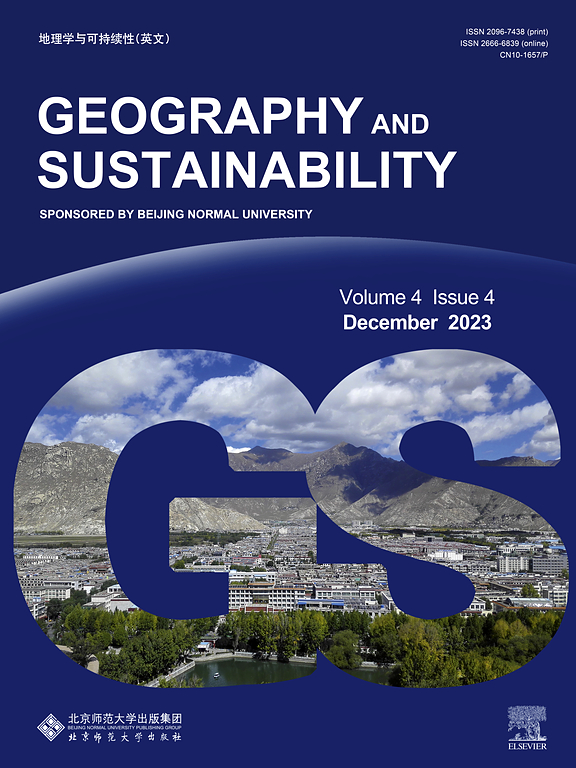生态修复通过提高长江典型流域的生态恢复力来增强生态系统的稳定性
IF 8
1区 环境科学与生态学
Q1 GEOGRAPHY, PHYSICAL
引用次数: 0
摘要
近几十年来,为了提高生态系统的稳定性,生态恢复(ERs)得到了广泛的应用。然而,它们对生态系统稳定性的影响程度及其潜在机制仍然知之甚少。本研究结合生态系统服务提供的时间稳定性、生态抗性和生态恢复力,建立了一个综合的生态系统稳定性评价框架。利用植被指数趋势量化生态系统内能强度,利用偏最小二乘结构方程模型确定驱动生态系统稳定性的关键因子的路径和大小。以嘉陵江流域为例,研究结果表明,森林具有较强的生态系统稳定性,维持ES供应的时间稳定性和生态恢复力。农田的生态抗性最强,其次是森林和草原。生态修复项目主要在生态恢复力较低的北部和南部农田地区实施。路径分析表明,有利的气候条件显著增强了ES供应的时间稳定性,崎岖的地形增强了生态抗性。然而,破碎的景观斑块通过降低生态连通性破坏了稳定的ES供应,社会经济发展通过土地利用集约化降低了抵抗和恢复能力。值得注意的是,生态恢复力提高了生态系统的整体稳定性。研究结果表明,该框架为生态系统稳定性综合评价提供了系统方法,并为制定区域生态系统稳定性战略提供了重要见解。本文章由计算机程序翻译,如有差异,请以英文原文为准。

Ecological restorations enhance ecosystem stability by improving ecological resilience in a typical basin of the Yangtze River, China
Ecological restorations (ERs) have been widely implemented in recent decades to enhance ecosystem stability. However, the extent of their impacts on ecosystem stability and the underlying mechanism remain poorly understood. This study developed a comprehensive framework for ecosystem stability assessment by integrating the temporal stability of ecosystem service (ES) provision, ecological resistance, and ecological resilience. Additionally, ER intensity was quantified using vegetation index trends, while the pathways and magnitudes of key factors driving ecosystem stability were identified by partial least squares structural equation modeling. Using the Jialing River Basin as a case study, our results revealed that forests exhibited the highest ecosystem stability due to their enhanced capacity to maintain temporal stability of ES provision and ecological resilience. However, farmlands demonstrated the strongest ecological resistance, followed by forests and grasslands. ER projects were primarily implemented in northern and southern farmland regions characterized by low ecological resilience. Pathway analysis identified that favorable climates significantly enhanced the temporal stability of ES provision, and rugged topography improved the ecological resistance. However, fragmented landscape patches disrupted stable ES provision by reducing ecological connectivity, and socioeconomic development diminished both resistance and resilience through land-use intensification. Notably, ERs improved ecological resilience, which in turn elevated overall ecosystem stability. Our results indicated that the proposed framework provides a systematic approach for comprehensive ecosystem stability evaluation and offers critical insights for developing region-specific ER strategies.
求助全文
通过发布文献求助,成功后即可免费获取论文全文。
去求助
来源期刊

Geography and Sustainability
Social Sciences-Geography, Planning and Development
CiteScore
16.70
自引率
3.10%
发文量
32
审稿时长
41 days
期刊介绍:
Geography and Sustainability serves as a central hub for interdisciplinary research and education aimed at promoting sustainable development from an integrated geography perspective. By bridging natural and human sciences, the journal fosters broader analysis and innovative thinking on global and regional sustainability issues.
Geography and Sustainability welcomes original, high-quality research articles, review articles, short communications, technical comments, perspective articles and editorials on the following themes:
Geographical Processes: Interactions with and between water, soil, atmosphere and the biosphere and their spatio-temporal variations;
Human-Environmental Systems: Interactions between humans and the environment, resilience of socio-ecological systems and vulnerability;
Ecosystem Services and Human Wellbeing: Ecosystem structure, processes, services and their linkages with human wellbeing;
Sustainable Development: Theory, practice and critical challenges in sustainable development.
 求助内容:
求助内容: 应助结果提醒方式:
应助结果提醒方式:


